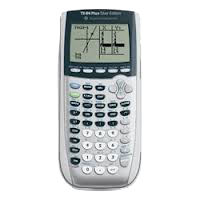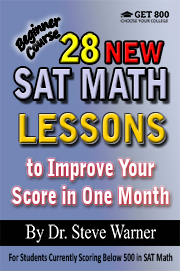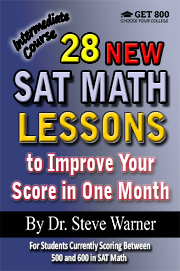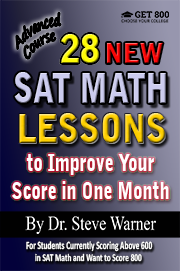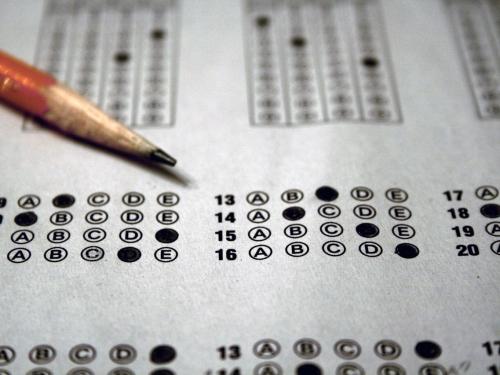
Overview Of The Math Sections On The SAT
The SAT is a standardized test used by colleges to gauge students’ academic abilities. The mere mention of the SAT instills a feeling of dread in many high school students. The exam has caused a lot of controversy in past years, so much so, that some colleges do not even have an SAT score requirement.
Love it or hate it – and you probably hate it – the SAT is an obstacle you have to overcome if you want to get into the college of your choice.
Note: The ACT is another standardized test that can be taken as an alternative to the SAT. Students should be aware that they can choose between these two tests. If you need help deciding which test is the best for you, take a look at the following page: The Differences Between the ACT and SAT
The SAT consists of five parts. There are two math sections, a reading section, a writing section, and an optional essay.
Each section begins with some directions.
SAT Math:
As an expert in SAT math, I will be focusing on the math sections of the SAT.
Each math section begins with some directions along with a small list of basic formulas. These include some area and volume formulas, the Pythagorean Theorem, and two special triangles.
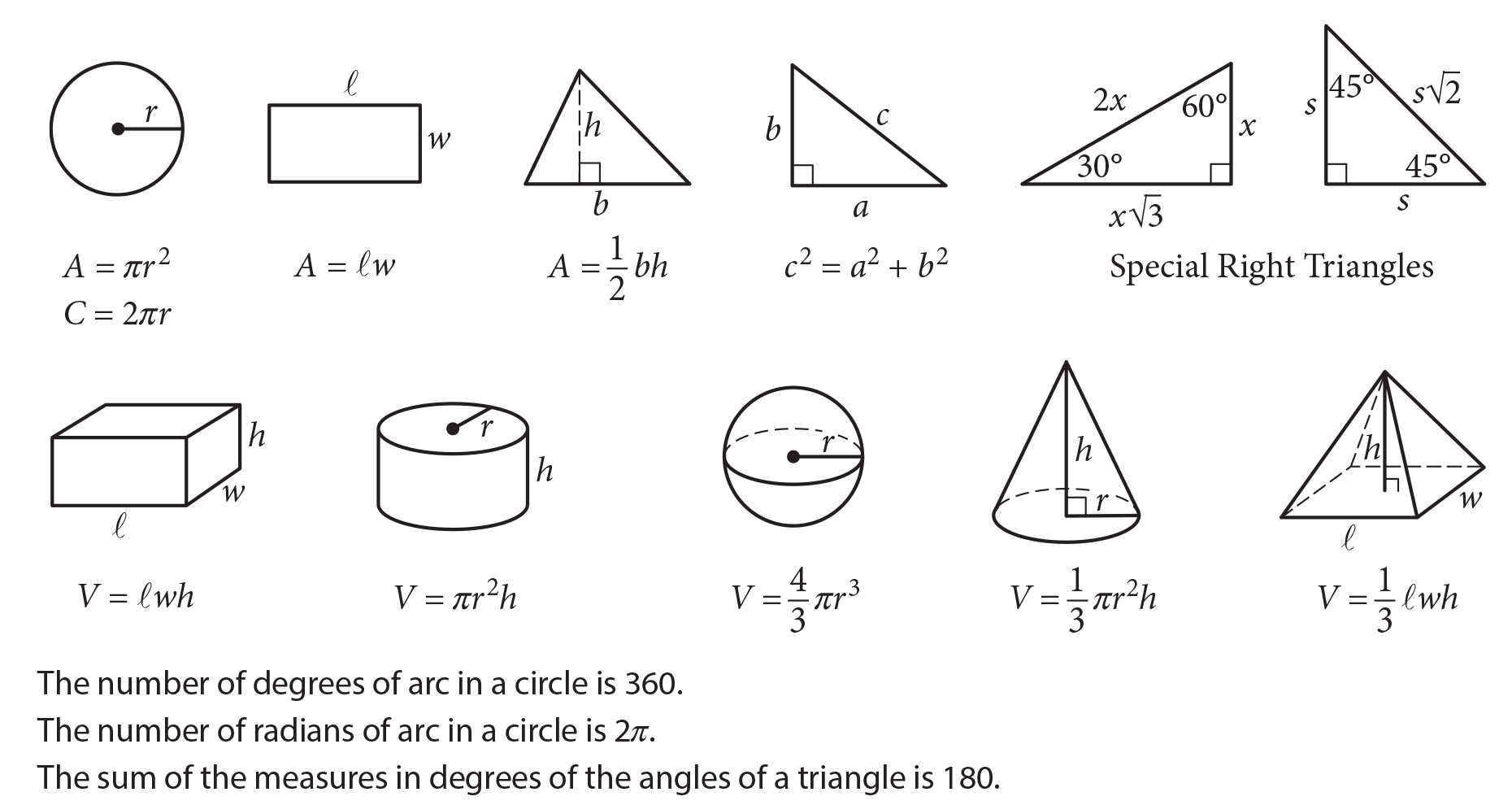
The two math sections can be described as follows:
(A) A 55 minute section consisting of 30 multiple choice questions and 8 free response questions (also called grid-ins). A calculator is allowed for this part.
(B) A 25 minute section consisting of 15 multiple choice questions and 5 grid-ins. A calculator is not allowed for this part.
Multiple choice questions:
Each multiple choice question comes with four choices. You get one point added to your raw score for each of these questions you get right, and there is no penalty for getting a question wrong.
Grid-in questions:
The “grid-in” questions require a free response. Make sure you learn how to enter your answers correctly. Many students get some of these questions wrong simply because they did not take a few extra minutes to learn the rules for gridding in answers properly.
On your answer sheet there are four columns.
In each column there is space on top to write your answers and there are bubbles below.
The computer only grades what you have marked in the bubbles.
The space above the bubbles is just for your convenience, and to help you do your bubbling correctly.
Never mark more than one circle in a column or the problem will automatically be marked wrong.
You do not need to use all four columns. If you do not use a column just leave it blank.
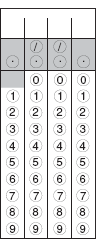
The symbols that you can grid in are the digits 0 through 9, a decimal point, and a division symbol for fractions.
Note that there is no negative symbol. So answers to grid-ins cannot be negative.
There are only four slots, so you cannot get an answer such as 52,326.
Sometimes there is more than one correct answer to a grid-in question. Simply choose one of them to grid-in. Never try to fit more than one answer into the grid.
If your answer is a whole number such as 2451 or a decimal that only requires four or less slots such as 2.36, then simply enter the number starting at any column. The two examples just written must be started in the first column, but the number 16 can be entered starting in column 1, 2 or 3.
There is no zero in column 1, so if your answer is 0 it must be gridded into column 2, 3 or 4.
Fractions can be gridded in any form as long as there are enough slots. The fraction 2/100 must be reduced to 1/50 simply because the first representation will not fit in the grid.
Fractions can be converted to decimals before being gridded in.
If a decimal cannot fit in the grid, then you can simply truncate it to fit. To truncate is to simply remove any numbers after the four slots have been filled. But you must use every slot in this case. For example, the decimal .167777777… can be gridded as .167, but .16 or .17 would both be marked wrong.
Instead of truncating decimals you can also round them. For example, the decimal .167777777… can be gridded as .168.
I like truncating better than rounding because there is no thinking involved and you are less likely to make a careless error.
Here are three ways to grid in the number 8/9:
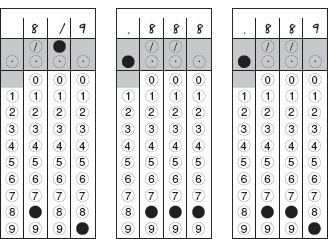
Never grid-in mixed numerals. If your answer is 2 ¼, and you grid in the mixed numeral 2 ¼, then this will be read as 21/4 and will be marked wrong. You must either grid in the decimal 2.25 or the improper fraction 9/4.
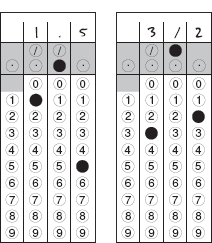
There is no guessing penalty for grid-ins, so you should not ever leave these blank.
Math topics covered:
There are four main math problem types on the SAT:
- Heart of Algebra
- Geometry and Trigonometry
- Passport to Advanced Mathematics
- Problem Solving and Data Analysis
Not everything tested on the SAT falls into one of these categories exactly, but this is close enough for our purposes.
As I always say, you most likely have all the mathematical knowledge you need already. So there is no need to relearn any mathematical theory. Reviewing these topics will happen naturally as you practice SAT math problems. This does not mean that you do not need to study. Many SAT questions are intentionally designed to trick you. Therefore you will still need to prepare. But your emphasis should be on learning SAT specific strategies, and practicing SAT math problems.
Difficulty level:
Math questions on the SAT come in 5 levels of difficulty. Level 1 questions are very straightforward, and Level 5 questions are usually quite tricky and may involve two or more steps to get to a solution. Each part of each math section roughly progresses in difficulty from Level 1 to Level 5.
What do I mean by a “part” of each math section? Well each math section has multiple choice questions followed by grid in questions. I like to think of the first part of each section as consisting of the multiple choice questions, and the second part as consisting of the grid in questions.
To simplify things a bit I like to think of each of these “parts” as falling into three Levels, the first third of the questions being easy, the second third medium, and the last third hard. For example, the 55 minute section has two parts: a 30 multiple choice question part and an 8 question grid in part. Roughly speaking, the first 10 multiple choice questions will be easy, the next 10 medium and the last 10 hard. Similarly, the first 3 grid ins will be easy, the next 3 medium, and the last 2 hard.
Note that none of this is set in stone: it is possible for an easier question to come after a harder question, but nonetheless most students will find it helpful to think of the test as broken up this way for the purposes of maximizing their score.
Calculator use:
Make sure you consistently practice with the calculator you plan to use. This way you will be comfortable with it on test day.
SAT Score
You get one point added to your raw score for each question you get right. There is no penalty for getting a question wrong, so you should not leave any answers blank. Each SAT has its own conversion chart that turns your raw score into your scaled math score. This is a number between 200 and 800.
To get an 800 in math you usually have to get every question correct. Once in a while there is an SAT where you can miss one question and still get a perfect score.
If you want to prepare in an efficient manner that will get you an 800 in SAT math in as short a time as possible, you should check out the 28 SAT Math Lessons series. Each book in this series will take you one step closer to a perfect score. Get the book for your score range and you will be given the exact types of problems to practice that will take you to the next score level. Click on the pictures below to view each book’s Amazon page.
Best of luck,

Dr. Steve
Get 800
P.S.: Here is a special offer on all of my SAT math prep books: SAT Math Prep Books Full Bundle

